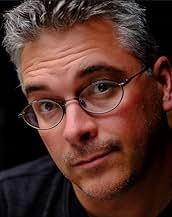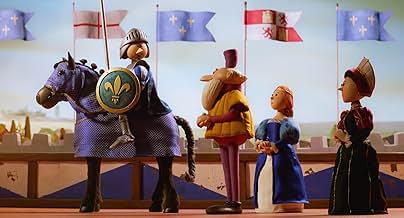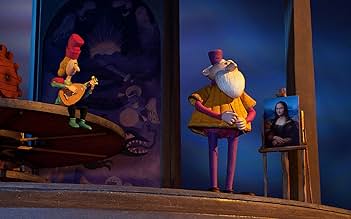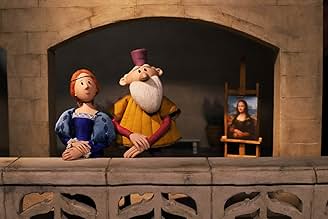IMDb RATING
5.8/10
828
YOUR RATING
Inventing flying contraptions, war machines and studying cadavers, Leonardo da Vinci tackles the meaning of life itself with the help of French princess Marguerite de Nevarre.Inventing flying contraptions, war machines and studying cadavers, Leonardo da Vinci tackles the meaning of life itself with the help of French princess Marguerite de Nevarre.Inventing flying contraptions, war machines and studying cadavers, Leonardo da Vinci tackles the meaning of life itself with the help of French princess Marguerite de Nevarre.
- Directors
- Writer
- Stars
- Awards
- 1 win & 3 nominations total
Daisy Ridley
- Marguerite
- (voice)
Matt Berry
- Pope Leo X
- (voice)
Stephen Fry
- Leonardo da Vinci
- (voice)
Aaron Heffernan
- Crowd
- (voice)
Ben Stranahan
- Page
- (voice)
Jim Capobianco
- The Physician
- (voice)
- …
Pierre-Luc Granjon
- Pierre-Luc
- (voice)
Jane Osborn
- Gravedigger Jane
- (voice)
Marion Charrier
- Annette
- (voice)
Teemu Oksanen
- Crowd
- (voice)
Janan Abir
- Crowd
- (voice)
Cristen Schwab
- Crowd
- (voice)
- Directors
- Writer
- All cast & crew
- Production, box office & more at IMDbPro
Featured reviews
**Review: "The Inventor" - A Visual Symphony of Art and Life**
The magic of cinema takes various shapes and forms, but few as mesmerizing as "The Inventor". The film is not only a love letter to Leonardo da Vinci's later years but also a masterpiece that combines the intricate art of stop motion animation with an emotionally captivating narrative.
From the moment the movie begins, the audience is transported into a breathtakingly crafted world that is not only aesthetically awe-inspiring but also teeming with intricate details. Jim Capobianco, an Academy Award nominee, showcases his prowess by weaving a tapestry of rich, historical narrative that marries fact with fiction, transporting viewers directly to da Vinci's side as he navigates the courts of France, searching for life's meaning.
Da Vinci, voiced by the inimitable Stephen Fry, is portrayed with such depth and gravitas that one could almost forget that they are listening to a voice and not actually sitting across from the genius himself. Fry's performance is both nuanced and powerful, infusing the film with an emotional anchor that draws the audience into Leonardo's world of innovation and introspection.
Marion Cotillard, an Oscar winner, lends her voice to a character that complements and contrasts with da Vinci in a beautiful dance of words and emotions. Daisy Ridley and Matt Berry also shine in their respective roles, adding layers of complexity to this rich tapestry of characters.
But the heart of the film lies in its visuals. Stop motion animation has long been an avenue for cinematic magic, but "The Inventor" elevates it to a new level. Each frame is a testament to countless hours of meticulous work, creating a fluidity of motion that is so lifelike it's staggering. The film's palette, drenched in the warm hues of the Renaissance, only serves to further its beauty, making each scene a work of art in and of itself.
What's even more surprising is how accessible this seemingly adult-centric narrative is for younger audiences. My 8-year-old daughter was completely captivated by it, her eyes glued to the screen from start to finish. While I initially thought the subject might be a tad mature for her, the film seamlessly balances its complex themes with moments of levity and wonder, making it universally engaging.
The underlying theme of the movie - the search for life's meaning - is one that resonates deeply. As Leonardo tinkers with flying contraptions, immerses himself in studies of the human body, and crafts machines that were far ahead of his time, we are left pondering our own journeys and our pursuits of purpose. The film doesn't just tell da Vinci's story; it challenges us to look inward and ask ourselves about our own passions and our quest for understanding.
Moreover, the film's sound design and score cannot be ignored. The intricate layers of ambient sounds, from the rustling of papers to the distant chatter of courtiers, envelop you in a soundscape that's as detailed as the visuals. The score, sweeping and evocative, only adds another layer of depth to this masterpiece.
In conclusion, "The Inventor" is not just a movie; it's an experience. It captures the essence of a man who was centuries ahead of his time, and it does so with grace, beauty, and heart. This is one of those rare films that not only entertains but also educates and inspires. Though it might not resonate with everyone in the same way, it was undeniably a pinnacle of entertainment for me. I'd watch it again and again, relishing in its details, pondering its questions, and simply basking in its visual splendor. Jim Capobianco's "The Inventor" is, without doubt, a cinematic triumph.
The magic of cinema takes various shapes and forms, but few as mesmerizing as "The Inventor". The film is not only a love letter to Leonardo da Vinci's later years but also a masterpiece that combines the intricate art of stop motion animation with an emotionally captivating narrative.
From the moment the movie begins, the audience is transported into a breathtakingly crafted world that is not only aesthetically awe-inspiring but also teeming with intricate details. Jim Capobianco, an Academy Award nominee, showcases his prowess by weaving a tapestry of rich, historical narrative that marries fact with fiction, transporting viewers directly to da Vinci's side as he navigates the courts of France, searching for life's meaning.
Da Vinci, voiced by the inimitable Stephen Fry, is portrayed with such depth and gravitas that one could almost forget that they are listening to a voice and not actually sitting across from the genius himself. Fry's performance is both nuanced and powerful, infusing the film with an emotional anchor that draws the audience into Leonardo's world of innovation and introspection.
Marion Cotillard, an Oscar winner, lends her voice to a character that complements and contrasts with da Vinci in a beautiful dance of words and emotions. Daisy Ridley and Matt Berry also shine in their respective roles, adding layers of complexity to this rich tapestry of characters.
But the heart of the film lies in its visuals. Stop motion animation has long been an avenue for cinematic magic, but "The Inventor" elevates it to a new level. Each frame is a testament to countless hours of meticulous work, creating a fluidity of motion that is so lifelike it's staggering. The film's palette, drenched in the warm hues of the Renaissance, only serves to further its beauty, making each scene a work of art in and of itself.
What's even more surprising is how accessible this seemingly adult-centric narrative is for younger audiences. My 8-year-old daughter was completely captivated by it, her eyes glued to the screen from start to finish. While I initially thought the subject might be a tad mature for her, the film seamlessly balances its complex themes with moments of levity and wonder, making it universally engaging.
The underlying theme of the movie - the search for life's meaning - is one that resonates deeply. As Leonardo tinkers with flying contraptions, immerses himself in studies of the human body, and crafts machines that were far ahead of his time, we are left pondering our own journeys and our pursuits of purpose. The film doesn't just tell da Vinci's story; it challenges us to look inward and ask ourselves about our own passions and our quest for understanding.
Moreover, the film's sound design and score cannot be ignored. The intricate layers of ambient sounds, from the rustling of papers to the distant chatter of courtiers, envelop you in a soundscape that's as detailed as the visuals. The score, sweeping and evocative, only adds another layer of depth to this masterpiece.
In conclusion, "The Inventor" is not just a movie; it's an experience. It captures the essence of a man who was centuries ahead of his time, and it does so with grace, beauty, and heart. This is one of those rare films that not only entertains but also educates and inspires. Though it might not resonate with everyone in the same way, it was undeniably a pinnacle of entertainment for me. I'd watch it again and again, relishing in its details, pondering its questions, and simply basking in its visual splendor. Jim Capobianco's "The Inventor" is, without doubt, a cinematic triumph.
I was quite nervous at the start here when I saw how many production companies were involved - it looked like a recipe for a mess. Well it isn't. It's certainly an amalgam of animated styles featuring everything from flat 2-D drawing to complex technical sketching and some stop-motion characterisations that really worked quite quirkily. It's the briefest of potted histories of the life of Leonardo da Vinci. We start in Rome where his sponsor - Cardinal de Medici - is constantly firefighting for him with Pope Leo X who wants him to do something a little more useful, and not dissect dead bodies in the middle of the night! It's that latter habit that sees him flee to the relative safety of King Francis I of France. The King wants the maestro to build him a castle, or a new city, or some fancy weapons - or probably all of the above. Leonardo doesn't really react well to commissions though, and soon his new benefactor is also beginning to lose his patience. Luckily, he has the princess Marguerite in his corner, and gradually the grudging support of their mother, the Queen. It can look a bit disjointed at times, the art is frequently quite contrasting - but that just makes the whole proposition a little more interesting and innovative. The drawings reminded me a little of the opening titles to Tom Riley's "Da Vinci's Demons" television drama - and the narrative emphasises quite engagingly the visionary nature of a man who quite literally walked a fine line between science, religion and a bonfire! It's probably twenty minutes too long, but once we get going there is plenty of imaginative action to keep it watchable.
I loved this film. I took my son whose 10 to see this as well and he really liked it as well. Interesting the combination of stop motion animation and hand drawn animation and water color painting is just remarkable in this interesting combination. It story of daVinci in his final days is inspiring and touching and also sending a message to kids don't be afraid to think for yourself and stand up for what you believe in. We need more material for kids like this and let them know it's ok to be who you are. Too bad this will probably get lost in the shuffle of other movies and it's a very small production company thst put it out. Highly recommend for a thought provoking non cgi kid film.
A delight, especially for those who enjoy history. This multi-style animated feature tells the story of Leonardo DaVinci's later life.
Spurning trendy 3D-driven computer animation with its dense content and over-caffeinated dialog, this film takes its time, spreads out, and dives deeply and gracefully into "The Maestro's" Italy and France that he inhabits. The primary animation style is 3D stop motion puppetry, but there is nothing old and jerky about this production. The motion is smooth, the backgrounds lush and detailed, and the pace measured and deliberate. With the occasional nod to old-fashioned elements (DaVinci's mouth that magically appears atop his thick beard when he speaks, for example), the puppetry is truly state-of-the-art.
King Francis I, King Henry VIII, King Charles I, and Pope Leo X all do the comedic heavy lifting. The scenes where the three monarchs repeatedly bicker and fight provide pure, fast-paced, and traditional animated delight, especially since these scenes are all stop motion. As the real world becomes too intense, threatening and ignorant to our hero, we are offered frequent glimpses of the world inside DaVinci's mind, and are treated with sepia-infused, gravity-defying, pencil animated scenes of pure joy, in an animated style reminiscent of DaVinci's famous sepia sketches come to life.
The score is subtle, with a noticeable lack of big, defining tunes. Instead, the songs - mostly offered by the princess (arguable the most impressive character of the movie with her understated progressivism and uncanny and hilarious ability to manager her brother, the French monarch) - seem to start and stop seamlessly with the dialog. The score weaves from lush support, to hints of Renaissance music (hinting at the Elizabethan period to come as ushered in by our hero), to a bizarre but effective hook melody in a 6/8-3/4 time signature reminiscent of Bernstein's America.
As said, a delight. An animated romp through Renaissance history with this tale teaching us that the primary agent of change, DaVinci, was no ordinary inventor.
Spurning trendy 3D-driven computer animation with its dense content and over-caffeinated dialog, this film takes its time, spreads out, and dives deeply and gracefully into "The Maestro's" Italy and France that he inhabits. The primary animation style is 3D stop motion puppetry, but there is nothing old and jerky about this production. The motion is smooth, the backgrounds lush and detailed, and the pace measured and deliberate. With the occasional nod to old-fashioned elements (DaVinci's mouth that magically appears atop his thick beard when he speaks, for example), the puppetry is truly state-of-the-art.
King Francis I, King Henry VIII, King Charles I, and Pope Leo X all do the comedic heavy lifting. The scenes where the three monarchs repeatedly bicker and fight provide pure, fast-paced, and traditional animated delight, especially since these scenes are all stop motion. As the real world becomes too intense, threatening and ignorant to our hero, we are offered frequent glimpses of the world inside DaVinci's mind, and are treated with sepia-infused, gravity-defying, pencil animated scenes of pure joy, in an animated style reminiscent of DaVinci's famous sepia sketches come to life.
The score is subtle, with a noticeable lack of big, defining tunes. Instead, the songs - mostly offered by the princess (arguable the most impressive character of the movie with her understated progressivism and uncanny and hilarious ability to manager her brother, the French monarch) - seem to start and stop seamlessly with the dialog. The score weaves from lush support, to hints of Renaissance music (hinting at the Elizabethan period to come as ushered in by our hero), to a bizarre but effective hook melody in a 6/8-3/4 time signature reminiscent of Bernstein's America.
As said, a delight. An animated romp through Renaissance history with this tale teaching us that the primary agent of change, DaVinci, was no ordinary inventor.
I just watched The Inventor, and I must say, it's a captivating animation film that left me pondering the life of Leonardo da Vinci. As someone who's always been fascinated by art, science, and history, I appreciated the unique blend of these elements in the movie.
One of the standout aspects of The Inventor is its stunning animation. The watercolor-inspired visuals transported me to the Renaissance era, immersing me in the world of 15th-century Florence. The attention to detail in the characters' designs and the environments is impressive, making every scene a feast for the eyes.
The storytelling is engaging, and I enjoyed seeing Leonardo's curiosity and creativity shine through. The film highlights his inventive spirit, showcasing his iconic designs and innovations. However, I felt that the narrative was a bit disjointed at times, jumping between different periods of Leonardo's life without clear transitions.
My only other criticism is that the supporting characters feel somewhat one-dimensional. I would have loved to see more depth and development in characters like Lorenzo and Francesco.
Despite these minor flaws, The Inventor is a charming film that sparked my interest in Leonardo's life and work. The movie's themes of creativity, perseverance, and innovation resonated with me, and I found myself reflecting on my own passions and pursuits.
Overall, I'd recommend The Inventor to anyone interested in art, history, or science. While it may not be a perfect film, its unique visual style and captivating storyline make it a worthwhile watch.
One of the standout aspects of The Inventor is its stunning animation. The watercolor-inspired visuals transported me to the Renaissance era, immersing me in the world of 15th-century Florence. The attention to detail in the characters' designs and the environments is impressive, making every scene a feast for the eyes.
The storytelling is engaging, and I enjoyed seeing Leonardo's curiosity and creativity shine through. The film highlights his inventive spirit, showcasing his iconic designs and innovations. However, I felt that the narrative was a bit disjointed at times, jumping between different periods of Leonardo's life without clear transitions.
My only other criticism is that the supporting characters feel somewhat one-dimensional. I would have loved to see more depth and development in characters like Lorenzo and Francesco.
Despite these minor flaws, The Inventor is a charming film that sparked my interest in Leonardo's life and work. The movie's themes of creativity, perseverance, and innovation resonated with me, and I found myself reflecting on my own passions and pursuits.
Overall, I'd recommend The Inventor to anyone interested in art, history, or science. While it may not be a perfect film, its unique visual style and captivating storyline make it a worthwhile watch.
Did you know
- TriviaMarion Cotillard voiced Louise of Savoy in both the English and the French version of the film.
- GoofsMichaelangelo is shown painting the ceiling of the Sistine Chapel under the patronage of Pope Leo X.
Michaelangelo was actually commissioned by the previous Pope, Julius II, and had completed the work a year before Leo X was elected.
- How long is The Inventor?Powered by Alexa
Details
Box office
- Budget
- €10,000,000 (estimated)
- Gross US & Canada
- $306,385
- Opening weekend US & Canada
- $190,031
- Sep 17, 2023
- Gross worldwide
- $2,061,835
- Runtime1 hour 40 minutes
- Color
- Aspect ratio
- 1.85 : 1
Contribute to this page
Suggest an edit or add missing content

Top Gap
What is the Canadian French language plot outline for Léo, la fabuleuse histoire de Léonard de Vinci (2023)?
Answer































